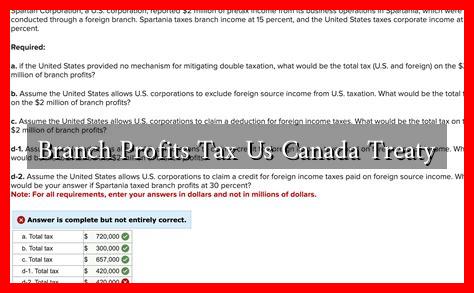-
Table of Contents
- Understanding the Branch Profits Tax: The US-Canada Treaty
- What is the Branch Profits Tax?
- The US-Canada Tax Treaty: An Overview
- Key Provisions of the Treaty
- Implications of the Branch Profits Tax for Canadian Businesses
- Case Study: A Canadian Corporation’s Experience
- Statistics on Cross-Border Investments
- Conclusion
Understanding the Branch Profits Tax: The US-Canada Treaty
The Branch Profits Tax (BPT) is a critical aspect of international taxation that affects how businesses operate across borders, particularly between the United States and Canada. This article delves into the intricacies of the BPT, its implications under the US-Canada tax treaty, and how it influences cross-border investments.
What is the Branch Profits Tax?
The Branch Profits Tax is a tax imposed on the earnings of foreign corporations operating in the United States through a branch rather than a subsidiary. This tax is designed to ensure that foreign entities do not avoid U.S. taxation on profits that are repatriated back to their home countries. The BPT is typically levied at a rate of 30% on the after-tax profits of the branch, although this rate can be reduced under tax treaties.
The US-Canada Tax Treaty: An Overview
The United States and Canada have a comprehensive tax treaty that aims to prevent double taxation and promote economic cooperation.
. The treaty, officially known as the Convention Between Canada and the United States of America with Respect to Taxes on Income and on Capital, was first signed in 1980 and has undergone several amendments since then.
Key Provisions of the Treaty
- Reduced Tax Rates: The treaty provides for reduced withholding tax rates on dividends, interest, and royalties, which can significantly lower the overall tax burden for Canadian companies operating in the U.S.
- Elimination of Double Taxation: The treaty allows for credits and exemptions that help prevent double taxation of income earned in one country by residents of the other.
- Branch Profits Tax Treatment: Under the treaty, the BPT rate can be reduced to 5% for certain qualifying Canadian corporations, making it more favorable for Canadian businesses.
Implications of the Branch Profits Tax for Canadian Businesses
For Canadian companies operating in the U.S., understanding the implications of the BPT is crucial. Here are some key considerations:
- Tax Planning: Canadian businesses must engage in effective tax planning to minimize their BPT liability. This may involve structuring operations as subsidiaries rather than branches to take advantage of more favorable tax treatment.
- Repatriation Strategies: Companies need to develop strategies for repatriating profits back to Canada without incurring excessive tax liabilities. This may include timing distributions or utilizing intercompany loans.
- Compliance Requirements: Businesses must ensure compliance with both U.S. and Canadian tax laws, which can be complex and require careful documentation.
Case Study: A Canadian Corporation’s Experience
Consider a hypothetical Canadian corporation, ABC Ltd., that operates a branch in the U.S. In its first year, ABC Ltd. earns $1 million in profits. Without the treaty, the BPT would impose a 30% tax, resulting in a $300,000 tax liability. However, under the US-Canada tax treaty, ABC Ltd. qualifies for the reduced BPT rate of 5%, leading to a tax liability of only $50,000. This significant reduction illustrates the importance of understanding and leveraging tax treaties.
Statistics on Cross-Border Investments
According to the U.S. Bureau of Economic Analysis, Canadian direct investment in the U.S. was approximately $400 billion in 2021, making Canada one of the largest foreign investors in the U.S. This investment is often structured through branches, making the BPT a critical consideration for many Canadian firms.
Conclusion
The Branch Profits Tax is a vital component of the tax landscape for Canadian businesses operating in the United States. Understanding the implications of the US-Canada tax treaty can lead to significant tax savings and more effective business strategies. By leveraging reduced tax rates and planning for repatriation, Canadian companies can enhance their competitiveness in the U.S. market. As cross-border investments continue to grow, staying informed about tax regulations and treaty provisions will be essential for success.
For more information on international taxation and the US-Canada tax treaty, you can visit the IRS website.




